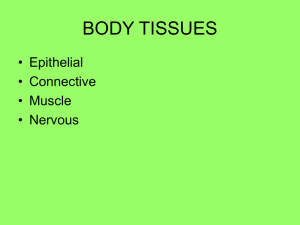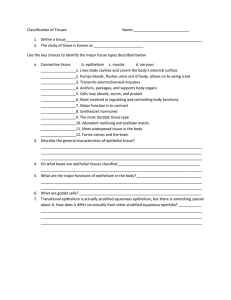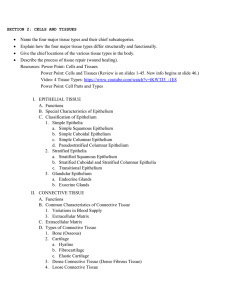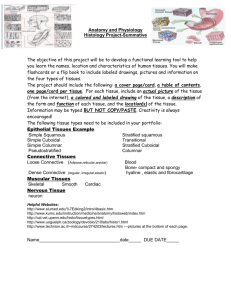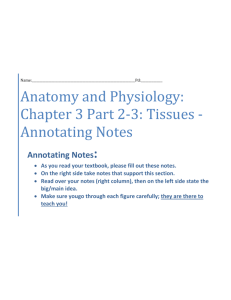Tissues
advertisement
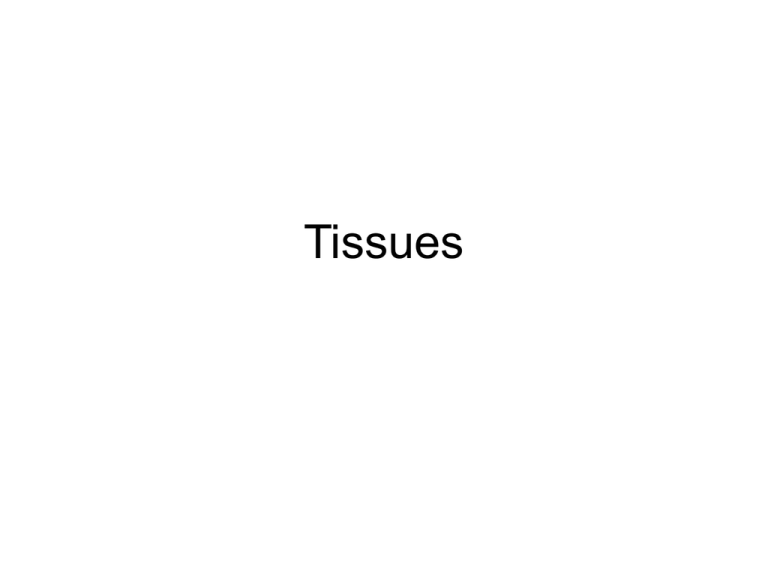
Tissues Definitions • Tissues are groups of cells that have the same structure and functions. • The study of tissues is called HISTOLOGY – Histos: tissue; ology: field of study Classification of tissues • Epithelial – Simple (one layer) • • • Squamous Cuboidal Cilindrical – – • – With microvilli or “brush border”. Cilia Pseudostratified Stratified (several layers) • • • • Squamous Cuboidal Cilindrical Transition Classification of Tissues • Connective – Proper • Mesenchyme • Loose connective – Areolar – Reticular – Adipose • Dense connective tissue – Dense regular – Dense irregular – Cartilage • Hyaline • Elastic • Fibrocartilage – Oseous – Blood Classification of Tissues • Muscular – Skeletal muscle – Cardiac muscle – Smooth muscle • Nervous tissue Epithelial tissue • Characteristics – Polarity: posses apical surface and basal surface. – Cellularity and special contacts (tight junctions). – Supported by connective tissue through basement membrane (basal lamina + reticular lamina). – Avascular: no blood vessels. – Regenerative: cells regenerate. • Function: lining of surfaces (interior or exterior to the body) Figure 3.5 Simple Epithelium • Simple Squamous epithelium: – Description: “scale like” flat cells. – Function: Allows passage of substances through filtration and diffusion. – Located in endothelium (lining of blood vessels), kidney glomeruli, air sacs in the lung (alveoli). Simple squamous Figure 4.1 Figure 4.2 Simple Epithelium • Simple cuboidal epithelium – Description: cells are of cubic form. – Function: secretion and absortion. – Located in kidney tubules, ovary surface Figure 4.3 Simple Epithelium • Simple Columnar (cilindrical) epithelium – – – Description: tall cells with round or oval nucleus. Function: Absorption that can be increase by cytoplasmatic projections of microvilli, secretion of mucus. If ciliated, it propels mucus by ciliary action. Located in digestive track, small intestine, uterus, lower respiratory system (bronchioles). Figure 4.4 Figure 4.5 Simple Epithelium • Pseudostratified columnar: – Description: single layer of cells, with apparent different heghts due to the position of the nucleus. – Function: secretion and propulsion of mucus. – Located in the trachea. Figure 4.6 Simple Epithelium • Pseudostratified columnar – Description: appears to be stratified squamous and cylindrical. – Function: allows stretching and containing urine (avoiding leakage into adjacent tissues). – Found in the bladder. Stratified Epithelium • Stratified Squamous epithelium – Description: multilayer squamous cells. – Function: protection of underlying tissues. – Location: Non keratinized (thin skin) are found in the esphagous, mouth,vagina. Keratinized (thick skin): palm and feet. Figure 4.7 Stratified Epithelium • Stratified Cuboidal epithelium – Description:bilayer of cuboidal cells. – Function: secretion. – Found in the ducts of glands such as mammary, sweat and salivary. Figure 4.8 Stratified Epithelium • Stratified Columnar epithelium – Description: Several layers of cylindrical cells. – Function: secretion. – Found in the male urethra. Figure 4.9 Stratified Epithelium • Transitional epithelium – Description: Resembles both stratified sqamous and stratified cuboidal epithelium; basal scells are cuboidal or cylindrical; surface cells are domed or squamous. – Function: Allows distension and stretching. – Found in the lining of the urethers, bladder and par of the urethra. Figure 4.10 Connective Tissue Proper • Areolar loose connective tissue – Description: loose collagen reticular and elastic fibers, prescence of fibroblasts, macrophages, mast cells. – Function: wraps provide nutrients and cushions organs. – Found under epithelia, surrounds capillaries and packages organs, . Connective Tissue • Function: Support/connect tissues. • Description: – Cells: • • • • Fibroblast: most common. Chondrocytes, ostoecytes: secrete respective extracellular matrix. Myofibroblasts Adipocytes – Fibres • Collagen • Estastin • Reticulin – Ground substance: amorphous transparent material. • Glucosaminoclycans (GAGs): Hyaluronic acid • Glycoproteins: fribrillin, fibronectin, integrin. Figure 4.11 Connective Tissue Proper • Reticular loose connective tissue – Description: predominant reticular fibers in a network. – Function: Provides structure to lymph organs. – Located: Found in lymph organs (thymus, lymph nodes). Figure 4.13 Connective Tissue Proper • Regular Dense connective tissue – Parallel arranged collagen fibers with fibroblasts. – Function: Attaches muscles to bones or bones to bones. Posses great tensile strength in one direction. – Forms tendons, ligaments, aponeurosis. Figure 4.15 Connective Tissue Proper • Irregular Dense connective tissue – Description: Irregular arranged fibers with fibroblasts. Forms the articulation capsules of organs and joints. – Function: Posses great tensile strength in several directions. – Location: reticular layer of the dermis, fibrous capsues of organs and joints. Figure 4.14 Connective Tissue Proper • Elastic Connective tissue – Description: Irregular arranged elastic fibers with fibroblasts. Makes the tunica media in blood vessels. – Function: Provides elasticity to the blood vessels. – Location: Tunica media of arteries and veins. Figure 4.16 Connective Tissue Proper • Adipose loose connective tissue – Description: adipocytes embeded in scarce areolar tissue. – Function: Energetic reserve, cushioning, thermal insulation. – Location: Hypodermis, kidneys, abdomen, breasts. Figure 4.12 Cartilage • Hyaline Cartilage: – Description: firm amorphous matrix synthesized by chondroblasts. Mature matrix holds chondrocytes in lacunae. – Function: Allows resilience, flexibility and compressibility to forces. – Located: embryonic skeleton, joints, nose, trachea, ribs. Figure 4.17 Cartilage • Elastic cartilage: – Description: similar to hyaline, but a grater ratio of elastic fibers. – Function: maintain structure while possesing great flexibility. – Location: outer ear, epiglotis. Figure 4.18 Cartilage • Fibrocartilage: – Description:similar to hyaline but a greater ratio of collagen fibers. – Function: posses high tensile strength but maintaining compressibility. – Located: intervertebral discs, knee joint, pubic symphisis. Figure 4.19 Bone • Compact bone – Description: Hard, calcified matrix. Impereameable. Vascularized. Osteocytes in lacunae. – Function: hematopoiesis (reb blood cell formation), storage of calcium and minerals. Composes the skeleton. – Location: bones Figure 4.20 Figure 4.21 Blood • Description: red, white cells and fibrous proteins (firbinogen) in a fluid matrix (plasma) • Function: transport of nutrients, wates, gases throughout the body. • Located: within blood vessels. Figure 4.22 Muscle • Skeletal muscle – Description: long, cylindrical, multinucleated, and striated. – Function: Voluntary movement; locomotion. – Located: skeleton Figure 4.28 Figure 4.30 Muscle • Cardiac Muscle – Description: branched, striated, uninucleated cells, connected by cell juntions (intercalated discs) – Function: propulsion of blood from the heart. – Location: heart. Figure 4.31 Muscle • Smooth muscle – Description: spindle shaped, uninucleated, no striations. – Function: creates peristaltic movement in digestive system and involuntary contraction of arrestor pili. – Lacted: hollow organs, dermis Figure 4.32 Nervous tissue • Description: Composed mainly by neurons and support cells (glial cells). • Function: transmit electrochemical signals to sense and control the body. • Location. Brain, spinal cord, nerves. Figure 4.33 Figure 4.35 Figure 4.37 Figure 4.38 • Note: to extra practice, you find an atlas in the lab book as well as a tutorial in the PhysioEx CD.

